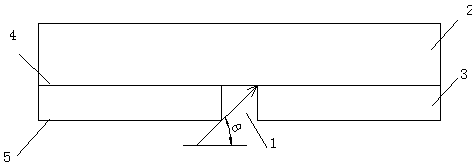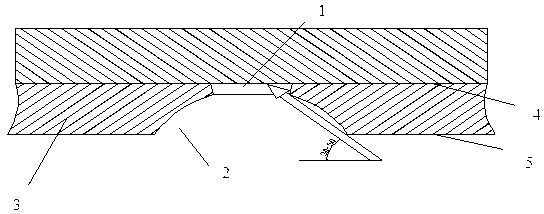Vapor plating method for organic light-emitting diode
A luminescence and diode technology, which is applied in the evaporation field of organic electroluminescent diodes, can solve the problems of inaccessible substrates, etc., and achieve the effects of improving service life, increasing utilization rate, and avoiding deformation of the board surface
- Summary
- Abstract
- Description
- Claims
- Application Information
AI Technical Summary
Problems solved by technology
Method used
Image
Examples
Embodiment 1
[0035] A mask for evaporation, such as figure 2 As shown, the thickness is 50 μm and the shape is a quadrilateral metal plate, which includes an ITO surface 4 and an evaporation surface 5 in contact with indium tin oxide (ITO). The mask plate has through holes that penetrate the ITO surface and the evaporation surface. The size of the opening 1 of the through hole on the ITO surface is smaller than the size of the opening 2 on the vapor deposition surface. Invar alloy is selected as the mask material, and the double-sided etching process is adopted. image 3 It is a schematic diagram of mask and ITO surface matching.
[0036] Etch from the ITO surface 4 of the mask to form as figure 2 The opening 1 on the ITO surface of the middle mask has a depth of 15μm and a lateral dimension of 70μm. It is etched from the vapor deposition surface 5 of the mask to form as figure 2 The opening 2 on the middle vapor deposition surface, and ensure that the opening 2 on the vapor deposition surf...
Embodiment 2
[0040] A mask for vapor deposition, with a thickness of 100 μm and a quadrilateral metal plate, including two surfaces, an ITO surface in contact with indium tin oxide (ITO) and a vapor deposition surface. The mask has a through ITO surface and a vapor deposition surface. The size of the opening on the ITO surface of the through hole of the plating surface is smaller than the size of the opening on the vapor deposition surface.
[0041] The vapor deposition mask is a quadrilateral nickel-cobalt alloy metal plate. The ITO surface of the mask has an opening depth of 35 μm and a lateral dimension of 70 μm. The opening on the vapor deposition surface coincides with the center of the ITO surface opening of the template, and the vapor deposition surface The center of the opening is symmetrical, the depth is 65 μm, the lateral dimension is 140 μm, and the wall of the opening on the evaporation surface has a certain concave arc, forming an evaporation angle of 30°. By separately controll...
PUM
| Property | Measurement | Unit |
|---|---|---|
| thickness | aaaaa | aaaaa |
| thickness | aaaaa | aaaaa |
Abstract
Description
Claims
Application Information
 Login to View More
Login to View More - Generate Ideas
- Intellectual Property
- Life Sciences
- Materials
- Tech Scout
- Unparalleled Data Quality
- Higher Quality Content
- 60% Fewer Hallucinations
Browse by: Latest US Patents, China's latest patents, Technical Efficacy Thesaurus, Application Domain, Technology Topic, Popular Technical Reports.
© 2025 PatSnap. All rights reserved.Legal|Privacy policy|Modern Slavery Act Transparency Statement|Sitemap|About US| Contact US: help@patsnap.com



